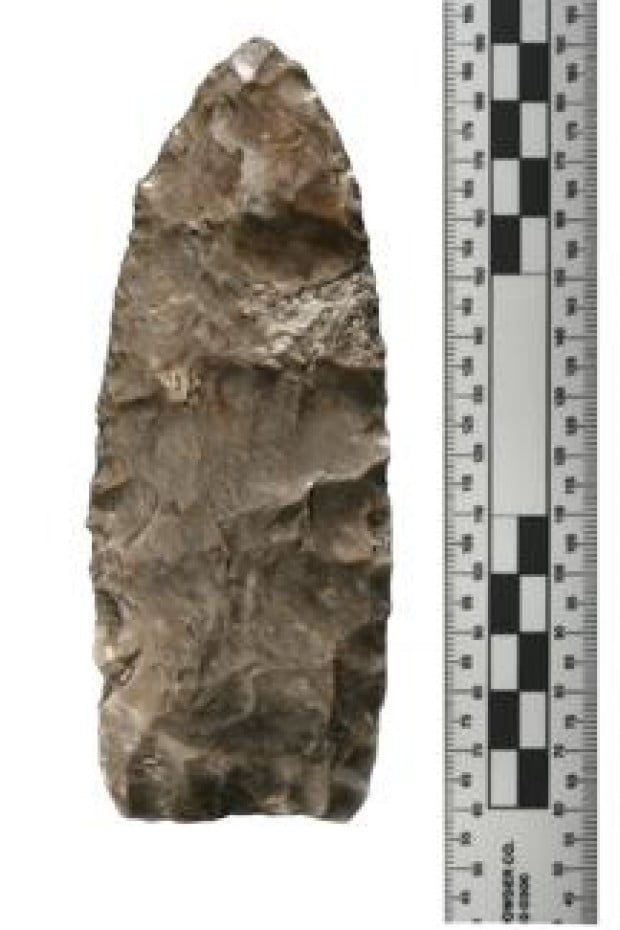A find of an 11,000-year-old Clovis spearhead has an archeologist up in arms because the owner of the site does not want any further research conducted.
By Melonie Magruder / Special to The Malibu Times
The discovery of a Clovis spearhead, believed to be thousands of years old, at a local home construction site has the homeowner and an archeologist at odds on what should be done with the site. The property owner wants to finish her home and move in, the archeologist wants to preserve the site, called Farpoint, and be allowed to conduct further research.
In September of 2005, Gary Stickel was the archeologist of record at the Farpoint site, then being developed by the private homeowner, and hired to oversee excavation at what was known as an “architecturally sensitive site.”
“Other objects, scrapers and micro-tools, had been found on the property,” Stickel said. “So we knew it was a culturally sensitive site. Then we found the spear point.”
The approximately 8-inch long, stone spear point is a tool produced by the Clovis people, believed to be the first human inhabitants of the Americas.
Not only does that date the piece to more than 11,000 years ago, the site of its location is the farthest point west in North America that the Clovis tribes can be traced, thus the designation “Farpoint.”
Dennis Stanford, director of the Paleoindian/Paleoecology Program at the Smithsonian Institute, in a written affidavit that authenticated the spearhead, said “… until the discovery of the Clovis occupation level at the Farpoint site, no “in situ” Clovis age sites are known along the West Coast of the Americas.”
The property owner, who is not identified to protect her privacy and the integrity of the archeologically sensitive site, has been cooperative through the last few years of research, but is ready to occupy her new house. And, Stickel said, she has shut down any further excavation.
Under current state regulation, the property owner is responsible for the cost of archeological testing of sites before building can begin.
The Farpoint landowner said, “I have spent all I was required to spend and 10 times more to have this property surveyed.”
Raneika Brooks-McClain, the city’s planning staff liaison for the Native American Resource Advisory Committee, said, “If culturally significant artifacts are indicated when property is being developed, work stops and an architect is hired to investigate and make mitigation recommendations for further excavation to the homeowner. As per the California Environmental Quality Act, the state is responsible for preserving state resources and, usually, there is a Native American monitor on site to preserve the integrity of any possible human remains.”
In this case, the Native American monitor was Edgar Perez, who actually found the spear point.
“Though we didn’t find any human remains at this site, we had found several nice pieces,” Perez said. “But when I found the spear point, we knew we had something big.”
While any historical artifacts found are the property of the landowner, items are usually donated to local museums or cultural centers. The Clovis spearhead now resides at the Santa Barbara Natural History Museum.
“There might be evidence of an entire Clovis occupation on this property,” Stickel said, who has excavated at Machu Picchu in Peru and Achilles’ birthplace in Greece. “I am ready to oversee excavation for free and I can get a team of students to work for free. But the landowner isn’t interested in any further research on her property.”
The landowner said, “There is still controversy about the authenticity of the piece. You can’t carbon date stone. And, anyway, you can buy Clovis spear points on e-Bay.”
And, according to The London Times, which profiled the story recently, the landowner said, “I have followed all of the guidelines. I have worked to preserve the integrity of the site … Now, I want to move into my house.”
Though the spearhead was found nearly 18 months ago, home construction continued on the property.
Brooks-McClain said, “The architect of record failed to follow protocol and notify us of the significance of the find. Work would have stopped immediately and the grounds would have been tested further. As it is, excavation was completed, the house is finished and nothing further is required of the property owner.”
Stickel disputes that claim.
“I called the city immediately,” he said. “I submitted 11 different mitigation recommendations to preserve the integrity of the site. I’m not about invading the privacy of this property owner. But this site contained evidence of historically unprecedented significance.”
Brooks-McClain said the landowner is following protocol for finishing the property’s development.
“She is capping her driveway to preserve any archeological remains beneath it.”
“I am disturbed to hear that the site is not being properly preserved for testing,” Smithsonian’s Stanford said. “In Europe, the state is very keen about preserving cultural heritage. But in America, the rights of the property owner still take precedence over the interests of the state.”
Also, for the landowner, further excavation is also a question of liability and so, has refused any further digging.
Stickel said the significance of the find is the American equivalent to that of finding the sealed door to King Tutankhamen’s tomb.
“This site is unique on the North American continent,” he said. “Every hole dug to plant another tree there will compromise the investigation into several cubic meters of history. You have to ask if our past is worth saving.”


